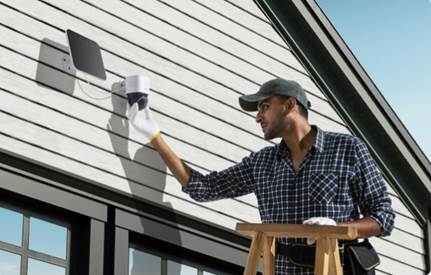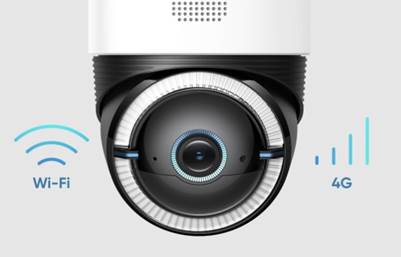Protecting
your home or business requires outdoor security cameras. They prevent burglars,
detect suspicious activity, and give vital footage. Proper installation ensures
cameras function well and cover everything. This article covers outdoor
security camera setup, from equipment selection to maintenance. Follow best
practices when installing your first camera or upgrading an existing system for
optimal performance and peace of mind. Let's examine the tools, positioning
advice, and step-by-step instructions needed for installation.

What Tools and Equipment Do You Need?
Must-Have Installation Tools
Installing
an outdoor security camera requires a power drill with bits, a screwdriver,
ladder, tape measure, pencil, level, and safety gear such as gloves and
goggles. A stud finder and fish tape assist route wires through walls. Also
needed are outside wall anchors and screws. Wireless setups require a
smartphone or tablet. A voltage tester ensures secure connections. Preparing
these tools saves time and prevents installation hiccups. Proper preparation
enables a smooth operation and a reliable camera setup.
Choosing the Right Camera Type
Selecting
an outside security camera is crucial. Permanent installations benefit from
wired cameras' reliable connections but power and drilling requirements.
Rentals and temporary setups benefit from wireless cameras' ease of
installation. Rain and dust protection is best with IP65 or higher weatherproof
certifications. Check for night vision, motion, and mobile app connectivity.
Wide-angle cameras cover more. Some variants have security floodlights or
sirens. The eufy 4G LTE Cam S330 is a good choice for rural places because it
supports 4G. Match camera features to location and budget.
Pre-Installation Checklist
To
simplify outdoor security camera installation, use a checklist. Check Wi-Fi
coverage before deploying wireless cameras. Second, prepare electricity outlets
or extension cords. Third, locate entryways and blind spots. To confirm camera
feed functionality, test it indoors. Refer to the user handbook for mounting
instructions. Provide weather sealing and cable covers. Finally, check local or
HOA visible camera laws. Complete these steps before starting to avoid
surprises and achieve a compliant, effective configuration that maximizes
protection and efficiency.

Where Should You Install Outdoor Security Cameras?
Best Camera Placement for Maximum Coverage
Setting
up an outdoor security camera requires strategic positioning. Install cameras
at the front, back, and garage doors. Include driveways and walkways. For a
clear view, tilt the camera down. Corner installations reduce blind areas by
capturing overlapping zones. If your home has multiple stories, place cameras
at different heights for diverse views. Avoid hiding lenses behind trees or
bushes. Proper placement provides full coverage, increases footage quality, and
deters intruders.
Areas to Avoid or Supplement
Avoid
positioning cameras in direct sunlight to avoid glare and washed-out footage.
Mounting near outside lights may impair night vision. Avoid dense foliage
unless periodically maintained. Avoid very high points, which may diminish
detail. Add units to side alleys and basement windows. Reduce coverage gaps
using overlapping fields of vision. Consider doorbell cameras for close-ups.
Know where not to install a camera, as well as where to install one for
comprehensive protection.
Height and Angle Tips for Clear Views
Outdoor
cameras should be 8–10 feet above ground to discourage tampering but capture
facial details. Full-body, clean photos require a slight angle down. Avoid
crazy angles that distort views. Choose cameras with flexible mounts or corner
brackets for wide coverage. Avoid facing cameras in sunlight or streetlights.
Adjust angles on your phone or monitor's live view before tightening. Proper
height and angle enhance footage clarity and ensure your security camera outdoors captures useful
and identifiable video.
Step-by-Step Outdoor Security Camera Installation
Mounting the Camera
Based
on the camera bracket, pencil-mark the mounting holes. Drill holes with a power
drill and add wall anchors. Screw the bracket in place. Mount the camera and
tilt it for optimal vision. Level it to guarantee straightness. Brick and
concrete surfaces require masonry bits and anchors. Try to hide wiring to
prevent tampering. Secure and weatherproof the camera. Mounting carefully keeps
the camera safe and functions effectively in all conditions.
Connecting to Power and Network
Connect
wired cameras to a power outlet or run extension wires safely along walls.
Cover exposed connections with waterproof coverings. Connect the Ethernet
connection to your router or switch if the system supports PoE. Install
batteries or plug into an outlet for wireless models, then connect via the app.
Pair the camera with Wi-Fi using the pairing instructions. Make sure the
installation place has a good signal. Secure cables to prevent disconnections.
A stable power and network connection keeps your outdoor security camera
running 24/7.
Initial Testing and Setup
After
connecting, check your camera stream on the app or monitor. Check video, motion
detection, and audio if available. Change the viewing angle. Set up motion
zones to reduce false alarms. Choose cloud or local storage. Test alerts to
guarantee fast delivery. Make sure the camera saves footage appropriately.
Assess night vision ability in dim light. Check and adjust the field of vision.
This testing procedure guarantees your outdoor security camera works properly
and delivers reliable surveillance from the start.
Conclusion
Installing
a security camera outdoors increases security, deters criminal activity, and
offers comfort. You may create an effective surveillance system with the
correct tools, thoughtful positioning, and correct configuration. Every stage
helps to create a reliable outdoor security system, from selecting the right
camera to updating software. This tutorial offers a straightforward
installation and maintenance procedure, regardless of whether you're protecting
your home or business. Keep yourself updated and proactive, and take pleasure
in the assurance that your property is always safe and well-guarded.



